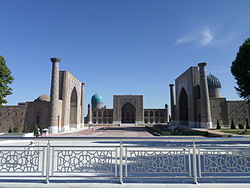Tajiks
[31] While agriculture remained a stronghold, the Islamization of Iran also resulted in the rapid urbanization of historical Khorasan and Transoxiana that lasted until the devastating Mongolian invasion.[26][33] The latter group includes Greeks who are known to have settled in the Tajikistan and Uzbekistan region before and after the conquests of Alexander the Great, and some of them were referred to as Dayuan by ancient Chinese chronicles.According to John Perry (Encyclopaedia Iranica):[23] The most plausible and generally accepted origin of the word is Middle Persian tāzīk 'Arab' (cf.The Muslim armies that invaded Transoxiana early in the eighth century, conquering the Sogdian principalities and clashing with the Qarluq Turks (see Bregel, Atlas, Maps 8–10) consisted not only of Arabs, but also of Persian converts from Fārs and the central Zagros region (Bartol'd [Barthold], "Tadžiki," pp.1000–1260) adopted the term and extended its use to cover Persians in the rest of Greater Iran, now under Turkish rule, as early as the poet ʿOnṣori, ca.The distinction between Turk and Tajik became stereotyped to express the symbiosis and rivalry of the (ideally) nomadic military executive and the urban civil bureaucracy (Niẓām al-Molk: tāzik, pp.[43] The 15th-century Turkic-speaking poet Mīr Alī Šer Navā'ī who lived in the Timurid empire also used Tajik as a reference to Persians.[18][17] In Afghanistan, a "Tajik" is typically defined as any primarily Dari-speaking Sunni Muslim who refer to themselves by the region, province, city, town, or village that they are from,[46][47] such as Badakhshi, Baghlani, Mazari, Panjsheri, Kabuli, Herati, Kohistani, etc.[54] Other sources however, for example the Encyclopædia Britannica, state that they constitute about 12–20% of the population,[55][56] which is mostly excluding Persianized ethnic groups like some Pashtuns, Uzbeks, Qizilbash, Aimaqs etc.[57][58][59] Tajiks (or Farsiwans respectively) are predominant in four of the largest cities in Afghanistan (Kabul, Mazar-e Sharif, Herat, and Ghazni) and make up the qualified majority in the northern and western provinces of Badakhshan, Panjshir and Balkh, while making up significant portions of the population in Takhar, Kabul, Parwan, Kapisa, Baghlan, Badghis and Herat.[70] Most Tajiks came to Russia after the dissolution of the Soviet Union, often as guest workers in places like Moscow and Saint Petersburg or federal subjects near the Kazakhstan border.[84] An autosomal DNA study by Guarino-Vignon et al. (2022), suggested that modern Tajiks show genetic continuity with ancient samples from Tajikistan and Turkmenistan.Both historical and more recent geneflow (~1500 years ago) shaped the genetic makeup of Southern Central Asian populations, such as the Tajiks.[91] Today, the great majority of Tajiks follow Sunni Islam, although small Twelver and Ismaili Shia minorities also exist in scattered pockets.Some of the famous Islamic scholars were from either modern or historical East-Iranian regions lying in Afghanistan, Tajikistan, Uzbekistan and Turkmenistan and therefore can arguably be viewed as Tajiks.[95] Tajikistan marked 2009 as the year to commemorate the Tajik Sunni Muslim jurist Abu Hanifa, whose ancestry hailed from Parwan Province of Afghanistan, as the nation hosted an international symposium that drew scientific and religious leaders.[97] The collapse of the Soviet Union and the Civil War in Afghanistan both gave rise to a resurgence in Tajik nationalism across the region, including a trial to revert to the Perso-Arabic script in Tajikistan.[98][23][99] Furthermore, Tajikistan in particular has been a focal point for this movement, and the government there has made a conscious effort to revive the legacy of the Samanid empire, the first Tajik-dominated state in the region after the Arab advance.For instance, the President of Tajikistan, Emomalii Rahmon, dropped the Russian suffix "-ov" from his surname and directed others to adopt Tajik names when registering births.[100] According to a government announcement in October 2009, approximately 4,000 Tajik nationals have dropped "ov" and "ev" from their surnames since the start of the year.[101] In September 2009, the Islamic Renaissance Party of Tajikistan proposed a draft law to have the nation's language referred to as "Tajiki-Farsi" rather than "Tajik."









Tajiks (disambiguation)TajikistanAfghanistanUzbekistanRussiaKyrgyzstanUnited StatesKazakhstanUkrainePersianPashtoRussianSunni IslamShia IslamIranian peoplesromanizedEastern IranianCentral AsiaethnicityWestern Iranian languagePamiriYaghnobiTajiks of XinjiangPamiri languagesNew PersianPersiansIraniansSovietFārsīwānDīhgānRomansSassanidIslamicBactriansSogdiansScythiansGreeksTurkic peoplesIslamic conquest of PersiaBactrianSogdianPersianateGhurid EmpireKartidsAncient Iranian peoplesProto-Indo-EuropeansFergana valleyPamir MountainsBadakhshanArab Conquest of IranIslamization of IranKhorasanTransoxianaSamarkandBukharaKhujandTermezAlexander the GreatDayuanRichard Nelson FryeIranianTurkicEncyclopædia BritannicaDasht-e KavirSoviet–Afghan WarJamiat-e IslamiBurhanuddin RabbaniSoviet ArmyAfghan governmentAhmad Shah MassoudPanjshir ValleyDehqanEncyclopaedia Iranicainvaded TransoxianaQarluq TurksZagrosChalukya dynastyRashtrakuta dynastyYusof Ḵāṣṣ-ḥājebQutadḡu biligQarakhanid TurksSamanid DynastyGhaznavidSeljuqAtābakGreater IranTonyukuk inscriptionsTashkentEncyclopaedia of IslamJalal ad-Din RumiMīr Alī Šer Navā'īTimurid empireDemographics of TajikistanShughniYaghnobi peopleDemographics of AfghanistanPresident of AfghanistanmujahidSunni MuslimWorld FactbookPersianized ethnic groupsPashtunsUzbeksQizilbashAimaqsMazar-e SharifGhazniqualified majorityPanjshirTakharParwanKapisaBaghlanBadghisIndo-AryanPashayi peopleNizari Isma’ilisTajiks of UzbekistanDemographics of UzbekistanSurxondaryo RegionSamarqandUzbekizationSharof RashidovSarikoliChinesepinyin